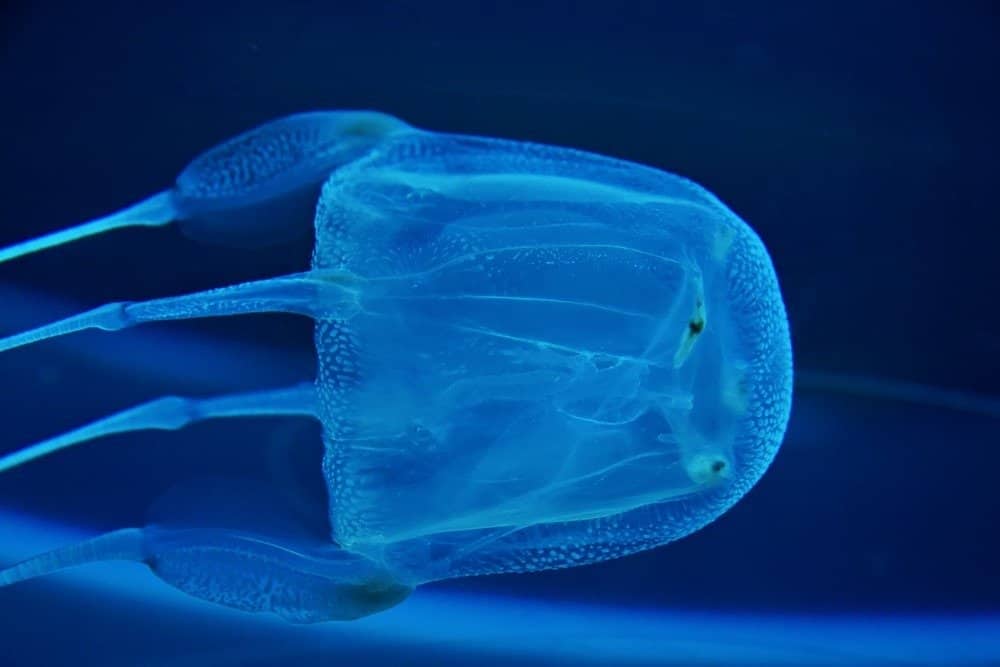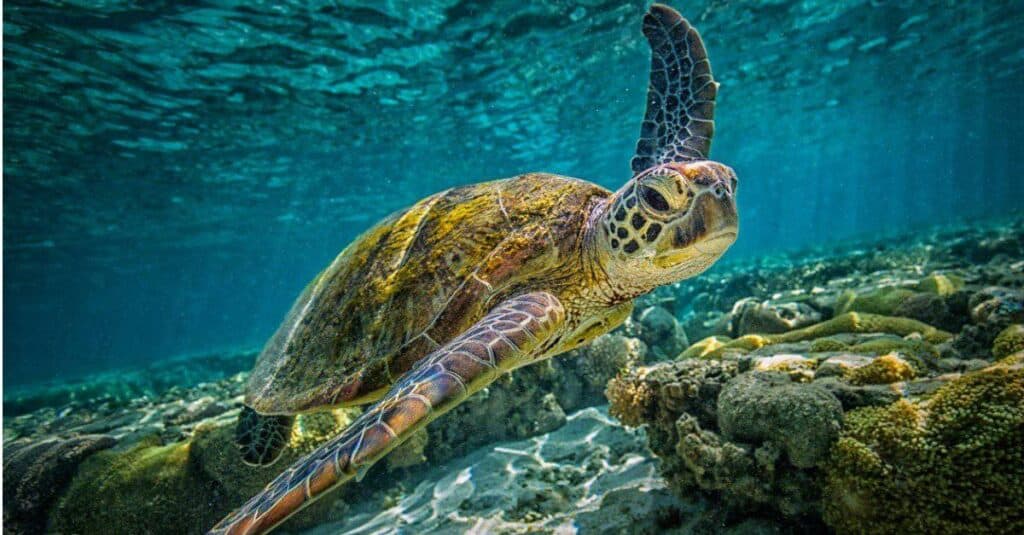Box Jellyfish
The Australian box jellyfish is the most venomous marine animal in the world!
Advertisement
Box Jellyfish Scientific Classification
Read our Complete Guide to Classification of Animals.
Box Jellyfish Conservation Status
Box Jellyfish Facts
- Prey
- Small fish, worms, crustaceans
- Main Prey
- Small fish
- Name Of Young
- Planula
- Group Behavior
- Solitary/Group
- Fun Fact
- The Australian box jellyfish is the most venomous marine animal in the world!
- Most Distinctive Feature
- Box-shaped bell
- Other Name(s)
- Cubozoan
- Predators
- Sharks, sea turtles, crabs
- Diet
- Carnivore
- Lifestyle
- Smack
- Bloom
- Common Name
- Sea wasp
- Special Features
- Stinging tentacles, 24 eyes
- Location
- Indo-Pacific region, Atlantic Ocean
- Slogan
- Venomous marine animals
- Group
- Smack, bloom
Box Jellyfish Physical Characteristics
- Color
- Blue
- Top Speed
- 4.6 mph
- Age of Sexual Maturity
- 2 months
- Venomous
- Yes
- Aggression
- Low
View all of the Box Jellyfish images!
Box Jellyfish Summary
Box jellyfish are venomous invertebrates inhabiting the world’s warm coastal waters. The more venomous species tend to live in the Indo-Pacific region and northern Australia, though certain species can be found elsewhere. They can both swim and see, unlike most jellyfish. Scientists attribute dozens of deaths every year to the stings of these often deadly animals. Because they live short lives, typically less than a year in length, they breed only once.

Estimates suggest that between 50 and 100 people die from box jellyfish stings every year.
©Nuttawut Uttamaharad/Shutterstock.com
3 Box Jellyfish Facts
- The most venomous marine animal: These animals are incredibly venomous, especially Chironex fleckeri, the Australian box jellyfish or sea wasp. Estimates suggest that between 50 and 100 people die from box jellyfish stings every year.
- Invertebrates: These creatures lack a backbone. Instead, they have soft, jellylike bodies with long tentacles. Given that they are invertebrates, they are not actually fish.
- They can swim: “True” jellyfish drift with the ocean’s currents instead of propelling themselves. Box jellyfish, however, are capable of moving under their own power, swimming at speeds up to four knots (4.6 miles per hour).
Box Jellyfish Classification and Scientific Name
Despite their name, box jellyfish are not fish. Rather, these invertebrates belong to the phylum Cnidaria. Cnidarians include soft-bodied animals such as sea anemones, corals, and jellyfish. Scientists divide these animals into four classes: cubozoans (box jellyfish), scyphozoans (true jellyfish), anthozoans (true corals, anemones, and sea pens), and hydrozoans (a diverse class containing hydroids, fire corals, siphonophores, and medusae).
The Cubozoa class subdivides into two orders, Chirodropida and Carybdeida. Chirodropida contains three families while Carybdeida contains five. Overall, Cubozoa contains over 50 species.
Types of Box Jellyfish: The 50+ Different Species
There are over 50 different species of box jellyfish in the world. Below are a few notable examples:
- Australian box jellyfish or sea wasp (Chironex fleckeri): This is one of the most venomous animals in the world, delivering an incredibly painful sting capable of killing its victims in minutes. It is also the largest species within Cubozoa.
- Irukandji jellyfish (Carukia barnesi): This species is actually one of several Irukandji jellyfish, notable for being both small and extremely venomous. Its sting causes Irukandji syndrome, a serious condition whose symptoms include back pain, muscle aches, nausea, sweating, headaches, high blood pressure, chest and abdominal pain, and trouble breathing.
- South African box jellyfish (Carybdea branchi): This venomous species inhabits the waters off South Africa.
- Chiropsoides buitendijki: This species is the sole member of the monotypic genus Chiropsoides.
- Pygmy box jellyfish (Chiropsella saxoni): Scientists named this species after the 9-year-old boy, Saxon Thomas, who discovered it in 2013. Thomas found it while playing in a canal on Australia’s Gold Coast. At less than an inch long, the pygmy box jellyfish certainly earns its name.
Box Jellyfish Appearance

Box jellyfish derive their name from the boxy appearance of their translucent, jellylike bells.
©Daleen Loest/Shutterstock.com
They derive their name from the boxy appearance of their translucent, jellylike bells. The bell contains a mouth and a stomach, but no brain. Clusters of long tentacles extend from each of the bell’s corners. These tentacles contain nematocysts, capsule-like structures that release a venomous thread and barb when properly stimulated. The barb enters the victim’s flesh, envenoming it and occasionally causing serious illness or death.
Cubozoans are unique among jellyfish in that they have 24 eyes arranged in six clusters. Four of their eyes are always pointed toward the sky and are complex structures much like the eyes of a human. These four are capable of forming images. The other twenty eyes are simpler and merely differentiate between darkness and light.
Cubozoan species vary widely in size. The smallest species, the Irukandji jellyfish (Carukia barnesi), has a bell diameter of only 0.39 inches. This is in contrast to the largest species, the Australian box jellyfish (Chironex fleckeri), which has a bell diameter of nearly a foot (11.8 inches) and tentacles as long as 9.8 feet. However, even the largest species only weigh up to 4.4 pounds. Because of their translucent, pale blue bodies, these invertebrates can be hard to spot in the water.
Box Jellyfish Distribution, Population, and Habitat
Box jellyfish inhabit warm coastal waters worldwide. This includes parts of the Atlantic, Pacific, and Indian Oceans. The deadliest species typically live in the Indo-Pacific region as well as off the coast of northern Australia. The Gulf of Mexico is another common haunt.
Inhabitants of the United States may encounter these invertebrates near states like Hawaii, Texas, and Florida. They are also common in countries such as Mexico, the Philippines, Malaysia, Thailand, Vietnam, Japan, South Africa, Indonesia, and Australia. Preferring to remain near the surface of the water instead of diving deeper, they tend to hug the coast as opposed to swimming out into the open ocean. Most species typically go no deeper than 184 feet. These factors increase the likelihood of jellyfish-human encounters.
Box jellyfish are not currently endangered.
Box Jellyfish Evolution and History
Because their soft bodies are not readily fossilized, the evolutionary history of box jellyfish is often difficult to piece together. However, scientists have discovered fossils of potential early cubozoans from the upper Jurassic (163.5 to 145.5 million years ago), upper Carboniferous (327 to 299 MYA), and the middle Cambrian (somewhere between 541 to 485.4 MYA). Specifically, fossils of the species Quadrumedusina quadrata and Anthracomedusa turnbulli come from the upper Jurassic and upper Carboniferous respectively.
Because Cubozoans find it difficult or impossible to cross large bodies of open water, significant differences developed between Atlantic and Indo-Pacific species. However, one extant genus, Alatina, has evolved to survive in deeper waters near the continental shelf. Certain species within this genus only enter shallow waters several days after a full moon to spawn.
Box Jellyfish Predators and Prey
Box jellyfish are carnivores with few predators. Unlike “true” jellyfish, they are able to pursue prey at speeds of up to 4.6 miles per hour. They use the nematocysts on their long tentacles to envenom their prey, after which they swallow them. Despite this adaptation, they do have a few notable predators.
What Do Box Jellyfish Eat?
These invertebrates mostly hunt and eat small fish. However, they also consume worms and crustaceans like shrimp and copepods.
What Eats Box Jellyfish?
The venom of cubozoans successfully keeps most predators at bay. However, certain marine animals like sharks and sea turtles actively target them. This includes green sea turtles, hawksbill sea turtles, and flatback sea turtles. Potential predators also include certain fish like barreleyes and some species of crabs.

Certain marine animals like sharks and sea turtles actively target them. This includes green sea turtles.
©iStock.com/Greg Sullavan
Box Jellyfish Reproduction and Lifespan
Box jellyfish reproduce both sexually and asexually depending on their current life cycle stage. As adults in the mature medusa life stage, they move inland from the ocean to rivers, estuaries, and marshes to spawn. This happens in spring. Depending on the species, males and females either release their sperm and eggs into the water together or the male transfers spermatophores to the female’s bell for fertilization of her eggs. Both males and females die soon after spawning.
Planulae (larvae) develop either outside the female’s body or inside, in which case she then releases them into the water. The free-floating planulae eventually attach themselves to objects in the water for security. Asexual reproduction occurs after the planulae develop into polyps with several tentacles. The polyps bud, which is a form of asexual reproduction wherein the organism divides itself into two or more separate organisms. After a short time spent as a juvenile medusa, each individual matures into a fully grown adult.
Cubozoans live up to one year, though their average lifespan is more like eight to nine months. Both males and females mature sexually by two months of age. Due to their short lifespans, they breed only once a year.
Box Jellyfish in Fishing and Cooking
Box jellyfish are more often a bycatch than a target of fisheries or sport fishers. This is partly to do with their painful, sometimes fatal sting. However, other kinds of jellyfish are an important part of the economy in some Asian countries like China. They may be salted and dried or desalinated to reduce the salty taste.
Although many species of jellyfish are toxic, it is possible in some cases to remove the venom and safely consume the flesh. In some areas of Asia, for example, jellyfish is considered a delicacy. It also comes with a number of health benefits including important nutrients, low fat content, and ample protein.
Though nutritional content varies somewhat by species, the approximate nutritional content of one cup (58 grams) of dried jellyfish is as follows: 21 calories, 3 grams of protein, and 1 gram of fat.
View all 285 animals that start with BThank you for reading! Have some feedback for us? Contact the AZ Animals editorial team.
Sources
- National Ocean Service, Available here: https://oceanservice.noaa.gov/facts/box-jellyfish.html
- Box Jellyfish, Available here: https://eol.org/pages/6681
- New World Encyclopedia, Available here: https://www.newworldencyclopedia.org/entry/Box_jellyfish
- Healthline, Available here: https://www.healthline.com/nutrition/can-you-eat-jellyfish#benefits
- Britannica, Available here: https://www.britannica.com/animal/Cubozoa
- Box Jelly Fish.org, Available here: https://boxjellyfish.org/how-do-box-jellyfish-reproduce-box-jellyfish-life-cycle/
- Nature, Available here: https://www.nature.com/articles/srep22290#:~:text=very%20near%20to%20the%20benthos,depths%20of%2039%E2%80%9356%20m.
- National Library of Medicine, Available here: https://www.ncbi.nlm.nih.gov/pmc/articles/PMC2842657/

















